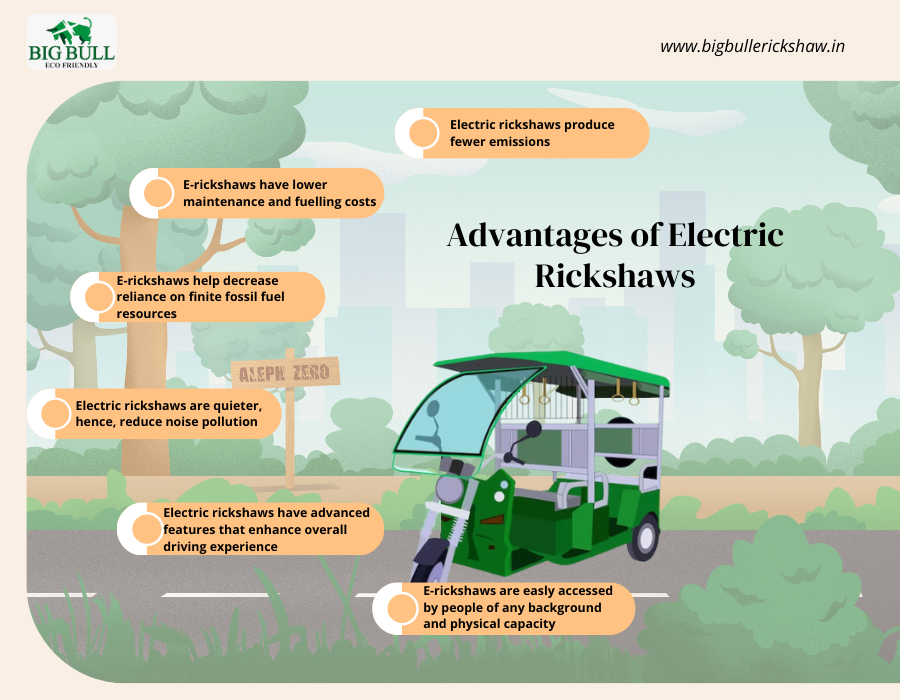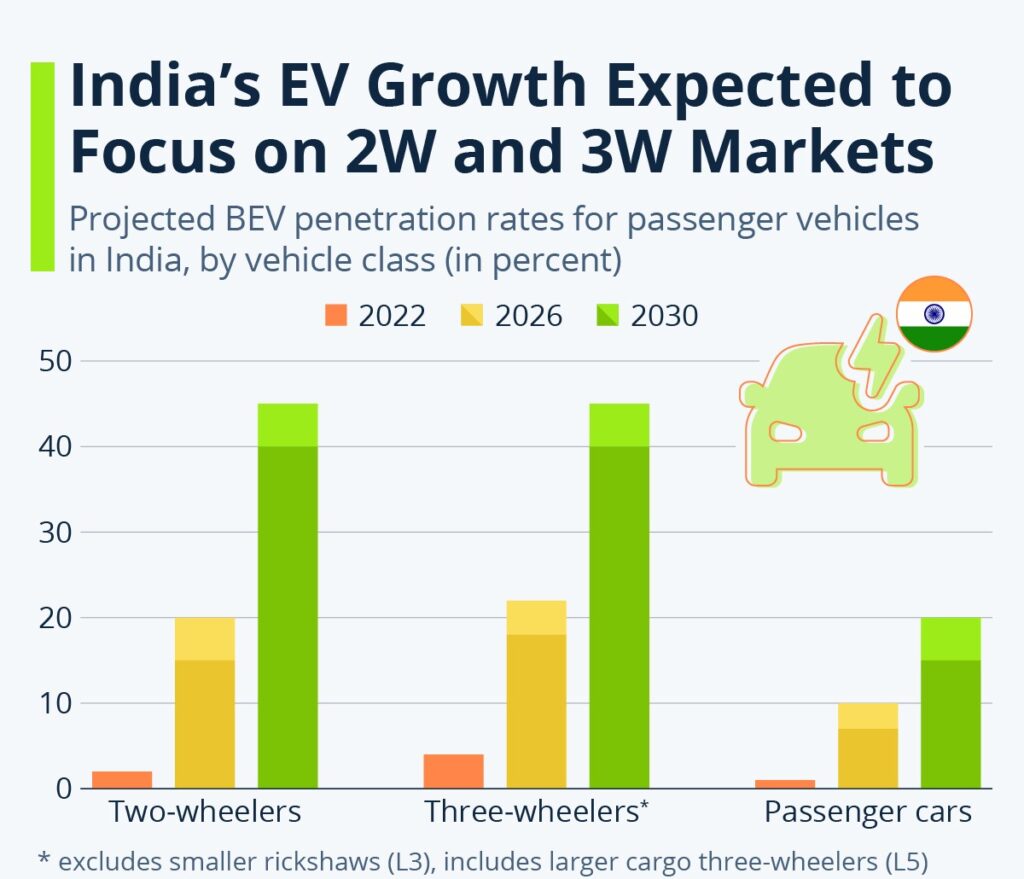In recent years, electric rickshaws, also referred to as electric tricycles or e-rickshaws have grown in popularity as an eco-friendly and sustainable form of transportation. These three-wheeled electric-motor-driven vehicles provide an environmentally friendly substitute for fossil fuel-powered conventional or auto-rickshaws. The need for inexpensive and effective urban transportation options, combined with the growing concern for environmental preservation, has propelled the evolution of eco-friendly electric rickshaw.
Table of Contents
ToggleAdvantages of eco-friendly electric rickshaw

Environmental Benefits
Because electric rickshaws have so many environmental benefits, they are an important part of the green mobility movement. First of all, when in operation, these cars produce no emissions, which contributes to the reduction of air pollution and the mitigation of the negative impacts of climate change. Eco-friendly electric rickshaw effectively contributes to a healthier environment and cleaner air compared to traditional rickshaws. Another benefit of electric rickshaws is that they lessen noise pollution, which promotes calmer and more serene urban settings. The last major advantage is the mitigation of the effects of climate change, since eco-friendly electric rickshaws help to slow down global warming by reducing greenhouse gas emissions.
Economic Benefits
Adopting eco-friendly electric rickshaw has several financial advantages. First off, compared to their fuel-powered counterparts, these cars are more affordable for drivers to operate and require less maintenance. Drivers can save money on fuel costs by using electricity instead of gasoline or diesel, which is substantially less expensive. Furthermore, the popularity of electric rickshaws generates jobs and opportunities for employment, especially in the manufacturing, assembly, and maintenance industries. Electric rickshaw manufacture and use support regional businesses, which fosters community development and economic prosperity.
Social Benefits
The environmental and social advantages of eco-friendly electric rickshaw led to improved accessibility for people of all backgrounds and physical capacities. All people can use these cars, which offer a practical and reasonably priced form of transportation. The public transportation system is also enhanced by electric rickshaws, which serve as a dependable and efficient substitute for crammed buses and traditional rickshaws. These cars improve cities’ liability by easing traffic, which makes traveling quicker and more comfortable for locals as well as tourists.
Challenges and Solutions for Eco-friendly Electric Rickshaw
Charging Infrastructure
One of the main obstacles to the widespread adoption of eco-friendly electric rickshaw is the dearth of charging stations. A strong network of charging infrastructure must be established in order to handle this issue. It is recommended that governments, local authorities, and private entities work together to strategically install charging stations, giving drivers of electric rickshaws convenient and easy access. The constraints of the current infrastructure for charging can also be addressed with creative solutions, such as mobile charging devices or solar-powered charging stations. The goal of government programs and subsidies should be to stimulate the construction of infrastructure for charging electric rickshaws.
Battery Technology and Range Anxiety
For drivers of electric rickshaws, battery technology and range anxiety is the fear of running out of charge are major concerns. Technological developments in batteries are essential to reducing these difficulties. The goal of ongoing research and development is to increase the longevity, capacity, and efficiency of batteries in order to increase the range of eco-friendly electric rickshaw. Range anxiety can also be reduced by informing people about the real range and battery life of electric rickshaws. More people may adopt this environmentally friendly form of transportation if the advantages of electric rickshaws are made more widely known and frequent charging stations are made available.
Safety and Regulations
To successfully integrate electric rickshaws into transportation systems, it is imperative to ensure the safety of both the riders and the vehicles. It is crucial to put safety regulations for electric rickshaws into effect. These regulations cover things like lighting, braking, and structural integrity. safe driving techniques can be promoted by training programs for eco-friendly electric rickshaw drivers, improving road safety in general. In order to guarantee the effective operation and safety of electric rickshaws on the roads, cooperation between government agencies and electric rickshaw producers is essential in order to set rules and specifications for vehicle construction, operating procedures, and certifications.
Case Studies: Successful Implementation of Electric Rickshaws

source: statista
India: A Pioneer in Electric Rickshaws
When it comes to the uptake and promotion of electric rickshaws, India has taken the lead globally. Drivers have been incentivized to convert to electric rickshaws by the government’s proactive policies and subsidies, resulting in a notable surge in their occurrences throughout the nation. In cities where electric rickshaws have taken the place of traditional rickshaws, the improvement in air quality is noticeable. the use of electric rickshaws by delivery services and e-commerce has made it possible for quick and environmentally responsible last-mile deliveries in crowded cities.
China: The Electric Rickshaw Revolution
China’s electric rickshaw market has grown at an impressive rate. The industry has undergone a revolution thanks to significant investments in R&D, as well as novel technologies and business strategies. The shift to electric mobility has been sped up by the government’s support of electric rickshaws, which takes the form of financial incentives and stringent emission regulations for traditional rickshaws. Other countries can learn from the Chinese market, which demonstrates how electric rickshaws can be used to cut pollution, increase energy efficiency, and change urban transportation systems.
European Cities Embracing Electric Rickshaws
Electric rickshaws are now a common feature of many European cities’ sustainable urban transportation plans. Their move toward more environmentally friendly transportation is consistent with their goal of cutting greenhouse gas emissions and raising air quality. In addition to buses, trams, and metros, electric rickshaws have effectively merged into the current public transportation infrastructure, offering a versatile and environmentally responsible first- and last-mile option. Positive user experiences and comments have prompted the adoption and growth of electric rickshaws in these cities, proving their viability as a means of promoting environmentally friendly transportation.
Future Prospects and Potential
Technology Improvements
The popularity of electric rickshaws will continue to rise due to improvements in battery capacity and efficiency. The main goals of research and development are to create batteries with increased durability, faster charging times, and longer range. Furthermore, incorporating renewable energy sources like solar panels or regenerative braking systems will improve the electric rickshaws’ sustainability. By optimizing energy usage and implementing smart charging and energy management systems, operating costs and environmental impact can be further reduced.
Global Expansion and Market Growth
Electric rickshaws have become more popular in developing and emerging countries, but there is a lot of room for them to spread throughout the world. Their cost-effectiveness, user-friendliness, and eco-friendliness make them a desirable choice for nations seeking to shift towards sustainable mobility. Electric rickshaws can also be used by tourist locations to provide eco-friendly transportation choices, which will improve the entire visitor experience. Global integration of eco-friendly electric rickshaw will be facilitated by cooperative efforts towards international standardization of technologies, safety rules, and charging infrastructure.
Integration with Smart Cities
The creation of smart cities can greatly benefit from the use of electric rickshaws. Integrated electric rickshaws into multimodal transportation networks allow cities to provide connected and smooth mobility choices. A practical and sustainable urban transportation network is ensured by integrating electric rickshaws with currently operating public transportation options, such as buses and metros. Effective urban planning and management can result from data-driven decision making that is fuelled by artificial intelligence and advanced analytics. This can optimize the use of electric rickshaws, plan routes, and run operations efficiently.
Conclusion:
An eco-friendly and sustainable option for urban transportation is electric rickshaws. They are a promising option for accomplishing green mobility goals because of their many benefits, which include social inclusivity, economic viability, and environmental benefits. For electric rickshaws to be widely used, however, issues with battery technology, safety regulations, and charging infrastructure must be resolved. Effective case studies from China, India, and several European cities show how electric rickshaws improve public transportation, employment opportunities, and air quality. Urban mobility could be revolutionized and a more sustainable and environmentally friendly future could be achieved by eco-friendly electric rickshaw. Thanks to ongoing technological advancements and growth opportunities in the green global market.






